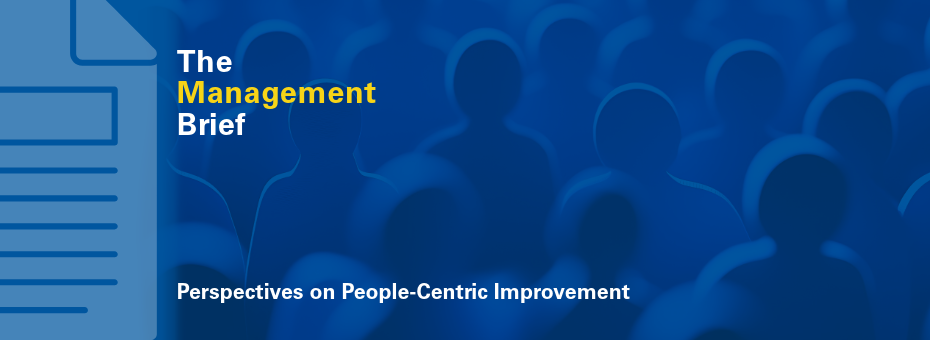In April, The Management Brief captured a variety of voices that shed light on the real source of foundational, sustainable improvement: the people doing the work. Anyone familiar with lean and LEI probably knows this to be true. But if that’s the case, why are so many organizations and individuals still not getting it?
April was truly a stellar month for The Management Brief as it focused on the centerpiece for all continuous improvement—the development of people. We heard multiple perspectives—from practitioners in the field to authors who have written in depth about this subject. There is much to learn.
I believe these articles all revolve around a key principle of the Toyota Way that I saw demonstrated day-to-day in my career in Toyota—respect for people. Respect for people in Toyota isn’t this existential concept about being good to people (though it, of course, embodies that too), but rather it is about how we make work better, more productive, more challenging, and rewarding for everyone. From Tyson and Noel on building ACEs, to Jacob speaking to building more productive and value-creating work, to Sarah’s strong emphasis on taking away “burden” from the worker, to Michael’s concept of engaging and visualizing problem-solving up and down the organization—all speak to the importance of respecting people as the drivers of improvement.
We were fortunate to present these current-day perspectives on people-centric improvement that offer new ways of transforming ourselves and our businesses.
Starting a Lean Transformation: Building a Team of ACEs
Tyson Heaton and Noel Thomas Jarin make the case that sustainable change starts with people, specifically a team of what they call “ACEs.” They write that it is the leaders responsibility to develop ACEs, and describe approaches that they have successfully used:
- Activate: “Activation is about creating the spark,” the authors write, and giving individuals some basics of improvement (e.g., identifying wastes) and encouraging them to experiment, improve, and want to do more. “Once their eyes open to waste, the doors of kaizen swing wide.”
- Cultivate: This is where leaders and team members work together to grow and learn. They don’t jump to a solution, but instead engage in the “messy,” hands-on work of “truly understanding the current state specific to a process and considering solutions tailored to that situation.”
- Elevate: Leaders need to recognize individuals for how they achieve goals—not just hitting the goals—and then move them on to additional challenges, such as mentoring others, more involved kaizens, and addressing increasingly bigger problems. Leaders need to make this happen because “lean thrives when team members grow.”
Solving the Productivity Paradox
Jacob Stoller points out the recent flawed approach of the Department of Government Efficiency (DOGE)—firing “tens of thousands of federal government employees with no more than a precursory AI-assisted determination that their work should be either eliminated entirely or automated by AI”—which has had a miniscule effect on government payroll and has put many government services in disrepair.
Jacob reminds us that the DOGE playbook is merely a repeat of other faulty business theories: ROI calculators that simply put a focus on cutting employees, use of industry cost and ratio benchmarks that equate improvements to both with headcount reductions, and failed attempts to apply technologies and automation as a sole means for improved productivity.
The alternative, of course, is to increase productivity as Toyota and other lean companies have done over the years, “largely due to a fundamentally different approach to management that emphasized respect for employees rather than seeing them as a cost to be reduced wherever possible.”
Jacob argues that leaders continue to rely on financial numbers that leave them “uninformed about the thousands of incremental problems that exist in workplaces and how work processes combine inputs to create value,” rather than adopting the processes used by Toyota and others to achieve game-changing productivity improvements. He asks if lean successes and emerging paradigms that combine technology with real process insights and the engagement of those involved in the work will encourage leaders “to step away from their computers and discover how value is created in their organizations?”
Personal and Organizational Transformation
Dr. Sarah Womack and Josh Howell, LEI President, talked about Sarah’s work at Toyota and how her growth as an individual within the company enabled her to contribute along with others to organizational improvements and high performance at the automaker. Her development was fueled, despite studying under Jeffrey Liker at the University of Michigan, by recognizing she still had a lot to learn when she got inside Toyota.
“I didn’t know what I didn’t know until I worked for Toyota,” said Sarah. “I thought I knew a lot, but it wasn’t until I got on the inside of the company that I realized how much I didn’t know and what the gap was and what is talked about in books and articles.”
Her grasp of Toyota concepts from the inside fed her transformation as it has done many others through the history of Toyota. “If this transformation is to going happen, it has to happen at the individual level, person by person… That collective group and common understanding is what ultimately can transform an organization. So that’s going from the individual to the macro or group level to have enduring high performance for the entire organization.”
Their discussion also explored many concepts addressed in Sarah’s recent book (Toyota’s Improvement Thinking from the Inside), including misconceptions about the Toyota Production System that she realized upon experiencing it firsthand: “Some of the common misconceptions are overemphasizing the tools, underemphasizing the principles and values, and underemphasizing the role that each individual plays. There are a lot of books focused on leaders only at the top level, for example CEO and C-suite. But the reality is that this is for every person within the organization and the idea being that everyone has and develops the kaizen mindset.”
Multi-level Visualization: Engage Everyone in Problem-Solving to Achieve Business Results
In this article, well-known lean author Michael Ballé provides guidance on how executives can bridge the gap between those who see the world in terms of business issues to be solved with business best practices and the lean practitioners who know to address problems in the workplace with lean tools.
Michael offers four steps for executives “to address business issues with lean tools and principles in order to teach people to find leaner countermeasures,” which are needed for lean transformation to occur:
- Grow a culture of problem-solving void of conflict, emotion, and arguments.
- Get executives to consider business problems as physical problems, not just a line on a budget.
- Go to the gemba to correctly understand the problem and hear from those who know the problem best.
- Encourage immediate countermeasures, build toward longer-term solutions with the people who do the work, and establish dialogue that identifies progress and prevents recurring mistakes.
The key for executives to successfully execute the four steps is visualization—with problem-solving visualized differently at different levels in the organization hierarchy. Visualization helps to root out problems that occur at interfaces, such as between specialties or between management levels. “Making problems visible on the shop floor at the team level with the usual lean tools and making problem-solving visible throughout the company are keys to creating the culture of problem-solving we seek, orienting it toward business issues.”
Next Month
The May releases of The Management Brief will focus on daily management and its relationship to strategy.
The Management Brief is a weekly newsletter from the Lean Enterprise Institute that bridges the gap between theory and practice in lean management. Designed for leaders focused on long-term success, it delivers actionable insights, expert perspectives, and stories from real-world practitioners. Each edition explores the principles of lean management—strategy deployment (hoshin kanri), operational stability and continuous improvement (daily management), and problem-solving (A3)—while highlighting the critical role of leadership. Subscribe to join a growing community of leaders dedicated to creating organizations built for sustained excellence.
The Lean Management Program
Build the capability to lead and sustain Lean Enterprises




